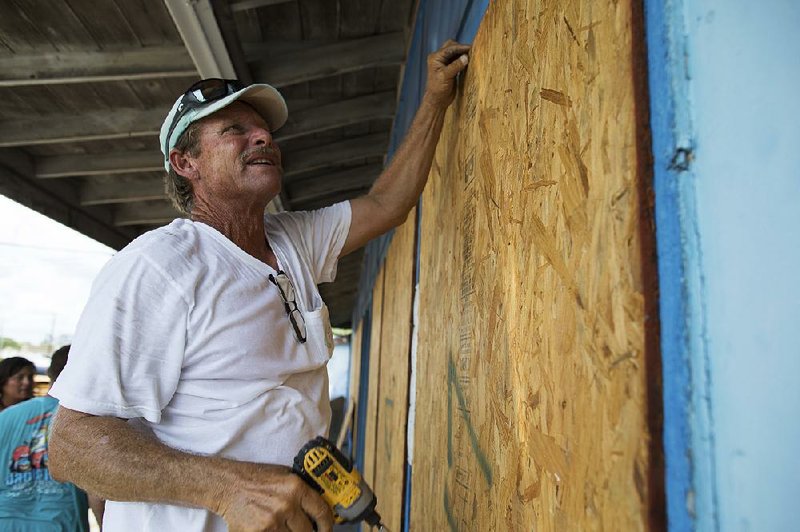HOUSTON -- Harvey intensified into a hurricane Thursday and steered for the Texas coast, carrying the potential of producing up to 36 inches of rain, 125 mph winds and 12-foot storm surges.
Forecasters labeled Harvey a "life-threatening storm" that posed a "grave risk." Millions of people braced for a prolonged battering that is predicted to have a reach of as much as 100 miles inland.
Landfall was predicted for tonight or early Saturday between Port O'Connor and Matagorda Bay, a 30-mile stretch of coastline about 70 miles northeast of Corpus Christi.
Harvey on Thursday transformed from a tropical depression into a Category 1 hurricane. Fueled by warm Gulf of Mexico waters, it was projected to become a Category 3 hurricane. The last storm of that category to hit the U.S. was Hurricane Wilma in October 2005 in Florida.
[HURRICANE TRACKER: Follow Harvey’s projected path]
Superstorm Sandy, which pummeled New York and New Jersey in 2012, never had the high winds and had lost tropical status by the time it struck. But it was devastating without formally being called a major hurricane.
"Harvey is looking like it's going to just meander around the area," National Weather Service meteorologist Penny Zabel said. "It's going to hang out for a few days, and that's why we're looking at such high rainfall amounts."
Numerous cities were shipping in sandbags, extra water and other items ahead of the storm.
Alex Garcia of Corpus Christi was buying bottled water, bread and other basics in Sugar Land, a Houston suburb, after dropping his daughter off at college in Houston.
He said grocery items likely were more available in Houston than back home, where Garcia, a beer distributor salesman, said stores were "crazy."
"We'll be selling lots of beer," he laughed.
Texas Gov. Greg Abbott has ordered the State Operations Center to elevate its readiness level, making state resources available for possible rescue and recovery actions. Abbott also pre-emptively declared a state of disaster for 30 counties on or near the coast, to speed deployment of state resources to any areas affected.
All seven Texas counties on the coast from Corpus Christi to the western end of Galveston Island have ordered mandatory evacuations of tens of thousands of people from low-lying areas. Officials in four of those counties ordered total evacuations and warned that they could not guarantee that people who stayed behind would be rescued if the need arose.
Voluntary evacuations have been urged for Corpus Christi and for the Bolivar peninsula, a sand spit near Galveston where many homes were washed away by the storm surge of Hurricane Ike in 2008.
Texas officials expressed concern that not as many people are evacuating as compared with previous storms.
"A lot of people are taking this storm for granted, thinking it may not pose much of a danger to them," Abbott told Houston television station KPRC. "Please heed warnings and evacuate as soon as possible."
Abbott has activated about 700 members of the state National Guard.
White House spokesman Sarah Huckabee Sanders said President Donald Trump was "briefed and will continue to be updated as the storm progresses."
As of late Thursday afternoon, Harvey was about 305 miles southeast of Corpus Christi, moving to the north-northwest at about 10 mph. Sustained winds were clocked at 85 mph.
"Trying not to be dramatic, but I fear epic flood catastrophe," tweeted Marshall Shepherd, a past president of the American Meteorological Society.
Meanwhile, the hurricane sent oil prices tumbling and gasoline margins soaring as it approached the refining hub on the Gulf Coast of Texas.
Harvey has forced workers off some energy platforms in the Gulf of Mexico, closed marine terminals and threatens to flood refineries in Houston and Corpus Christi.
With the storm "you have much less oil demand and you have a commensurate drop in product demand," in the likelihood of refinery shutdowns, Kyle Cooper, director of research with IAF Advisors in Houston, said by telephone. "There is a very serious risk of flooding."
Information for this article was contributed by Michael Graczyk, Frank Bajak, Seth Borenstein, Catherine Lucey, Diana Heidgerd, Jamie Stengle, David Warren and John Mone of The Associated Press; by Brian McNoldy and Jason Samenow of The Washington Post; and by Jessica Summers, Stephen Stapczynski, Ben Sharples and Grant Smith of Bloomberg News.
A Section on 08/25/2017

